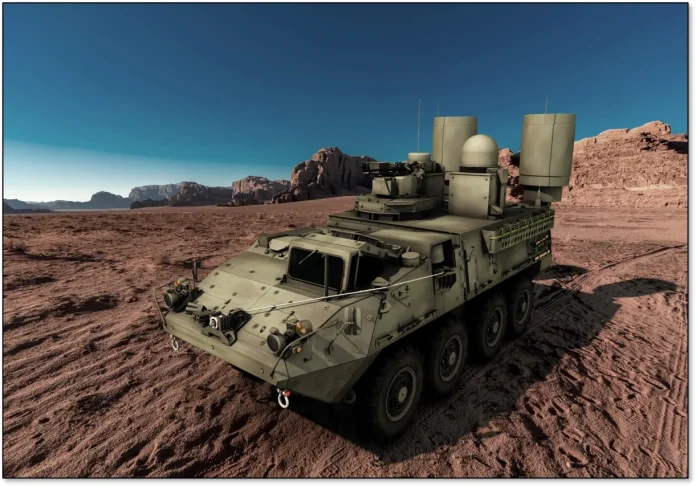
The US Army is moving ahead with the TLS-EAB programme which will provide operational-level cyber and electronic warfare effects for its manoeuvre force.
On 18th August the US Army commenced a $15 million, eleven-month Other Transaction Authority (OTA) agreement with General Dynamics and Lockheed Martin. This covers work the two firms will perform on phase one of the Terrestrial Layer System – Echelons Above Brigade (TLS-EAB) initiative.
US Army manoeuvre force Cyber and Electromagnetic Activities (CEMA) assets are undergoing a transformation courtesy of new capabilities. Army Brigade Combat Teams (BCTs) are receiving the TLS-BCT. This will be installed onboard a version of the General Dynamics M-1133 Stryker medical evacuation platform. M-1133 vehicles were selected as they have sufficient electrical connections for the vehicles’ CEMA payloads. Armoured BCTs will receive the TLS-BCT mounted on BAE Systems’ Armoured Multi-Purpose Vehicle (AMPV). The AMPV is replacing the FMC/BAE Systems M-113 tracked armoured personnel carriers in US Army service.
TLS-BCT
On 15th July, the army awarded a contract worth $58.9 million to Lockheed Martin covering the construction of three TLS-BCT prototypes. Both TLS programmes are managed by the US Army’s Programme Executive Office for Intelligence, Electronic Warfare and Sensors (PEO IEWS). The army says operational tests of the prototype TLS-BCT systems are planned before the end of 2023. The TLS-BCT will engage electromagnetic threats across wavebands of circa 30 megahertz/MHz to at least 18 gigahertz/GHz. The system will also use its electronic attack capabilities to inject malicious code into hostile computers and computer networks via red force communications.
The TLS-BCT replaces the Tactical Electronic Warfare System (TEWS) equipping M-1126 Stryker platforms and the TEW-Light (TEW-L) onboard General Dynamics Flyer-72 four-wheel drive vehicles. TLS-BCT also replaces General Dynamics’ AN/MLQ-44A Prophet Signals Intelligence (SIGINT) gathering vehicle. The TEWS and TEW-L are quick reaction capabilities replacing the Sabre Fury electronic attack system. Sabre Fury is based on SRC’s AN/VLQ-12(V)4/5 Counter Radio-Controlled EW system. This rapidly provided the US Army with a mobile SIGINT/electronic attack capability for forward-deployed units like the 2nd Cavalry Regiment based in Vilseck, southwest Germany. The system also equips the US Army’s Electronic Warfare Tactical Vehicle (EWTV). EWTVs were primarily developed for training and electronic warfare research and development.
Mission
The TLS Echelon Above Brigade (TLS-EAB) architecture complements the TLS-BCT. Whereas the latter focuses on the tactical battle, the TLS-EAB will perform operational-level CEMA. The system comprises two Oshkosh FMTV wheeled tactical vehicles. One carries a SIGINT and jamming system likely to detect and engage threats on similar wavebands to the TLS-BCT. The second will have an electronic protection system to safeguard friendly communications networks from electronic/cyberattack. This platform will also perform cyber/electronic attack to pre-empt hostile actions. However, unlike the first vehicle it will not collect SIGINT. A PEO IEWS spokesperson told Armada that the TLS-EAB will focus “on the higher and more strategic echelons of the army which require longer ranges and the abilities to interoperate with a broader range of adjacent service, coalition, and national and strategic partners”.
Service Entry
The TLS-EAB OTA agreement engages industry and academe for research and prototyping and are not procurement contracts. A press release announcing the TLS-EAB award stated that during phase one “both companies will participate in a competitive developmental process consisting of concept design, system design review and a software architecture demonstration”. The OTA is “is planned for five total phases consisting of concept design; prototype build, test and Integration; production readiness and operational assessment; equip and transition to a follow-on programme; and design and development of future material solutions”, the spokesperson continued. They added that “TLS-EAB prototype systems will initially be delivered to an operational unit for a testing event in 2025. Prototype systems will then be issued to the operational unit(s) as residual operational capabilities following the test”.
by Dr. Thomas Withington













